Breakeven analysis, what is it? Well to break even means to have made enough money to cover expenses and analysis means we’re examining something. In this article we’ll cover key concepts such as breakeven sales revenue, breakeven profit, overheads, among other key figures for our calculations and how we will use these concepts to assess Economic Viability of businesses and create sound budgets to work from.
Introduction to Breakeven Analysis and Economic Viability
If there’s one thing to know about PPX it’s that the Control Cycle is a key concept in our framework; there are three elements to the cycle, but we’ll focus on the second element, Economic Viability. This is crucial to any business because if your business isn’t economically viable then it simply isn’t going to survive long-term, so it’s hard to overstate the importance of this. The key question that arises is: is the Performance Evaluation every month good enough?
The best way to get an answer this question is through breakeven computation and analysis; it tells you if your performance in the current period is at the level you need it to be and help you set benchmarks and targets for future periods. This is where budgeting is crucial, where cost classification is important – all the stuff we talk about regularly feeds into this calculation of Economic Viability to determine if your business is strong enough to survive and grow.
Breakeven Sales Revenue, Breakeven Profit, and Overheads
There are other key numbers to derive from your budget and actual performance but break-even is the one that really tells you a story of your performance. In order to calculate your break-even sales revenue, you’ll need to calculate your break-even profit, which is actually really simple to do.
Breakeven Profit
Your breakeven profit is your total overheads; this makes sense because breaking –even essentially means generating enough profit to ensure you can cover these overheads without issue.
For example, if your total overhead costs are £145,125, then this is the minimum amount you’ll need to generate in gross profit as a firm.
This is where the budget comes in because your actual gross profit margin will fluctuate. Ideally, it won’t fluctuate too much (giving you some predictability to base future plans on) – if it does, your budgeting might not have been done well. The goal is always to hit the budgeted profit margins, even if you don’t achieve budgeted performance.
The Benefits of Breakeven Analysis
If we assume we don’t have actuals yet and we’re purely looking at the budget, we needed to generate £145,250 in gross profit to break even. However, we budgeted for £158,000 to give us a little space, meaning after covering overheads, we’d have £12,750 left over. This is known as the ‘Margin of Safety’ and is another key metric. This is the goal, to have your gross profit covering all your bills and leaving something left over at the end of it. Nobody aims to just breakeven of course, every business wants to be making a profit, but knowing your breakeven point is key to predicting profit and assessing business viability.
It’s important to know where it is because how close you are to it determines your success, when a company regularly exceeds it then it will be successful and not at risk of falling below it; inversely, companies that consistently barely reach their breakeven point are more likely to be struggling and consistently at risk of bankruptcy if they fall much farther below.
Simulating Activity Levels with Our Budget
Another benefit of breakeven analysis is that you can use it to simulate different activity levels (e.g. busy months like December over Christmas and quieter months like June, even though it’s different for many businesses). If your budgeted sales are £265,000 but you set a sales target of £300,000, you can recalculate your expected profit based on the same margins. Alternatively, if you know you’re going to lose a big customer and sales will drop significantly, you can use this to make a prediction on whether you’ll still breakeven or if you’ll need to find new supplementary revenues sources to make up the shortfall.
Breakeven Calculation Formula
To calculate your breakeven sales revenue, divide your total fixed costs (your overheads) by your gross margin percentage. This makes sense because your gross profit is your sales figure multiplied by your gross margin – so reversing that calculation shows what sales you need to hit to cover your costs.
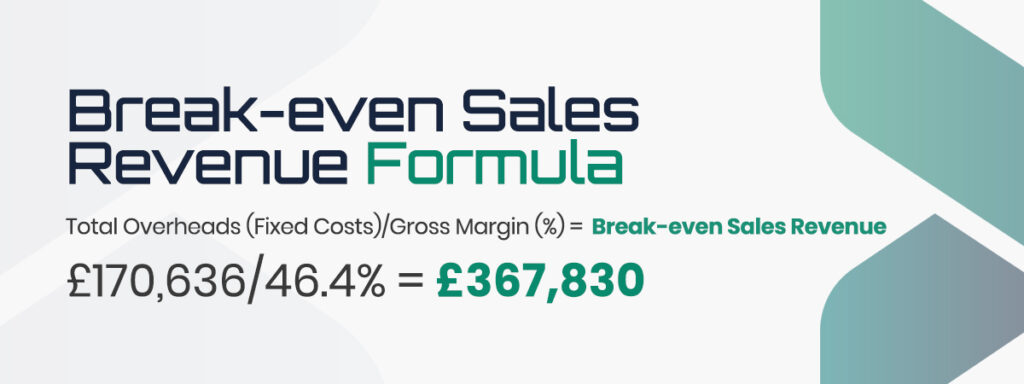
Worked Example
Planned Budget
For example, if your total overheads are £145,250 and your gross margin is 60.5% then we know our breakeven point is £145,250 divided by 60.5% which would result in a breakeven sales revenue of £239,876. Which means this is the absolute minimum amount we need to make in sales to break even. This figure will vary based on changes in overheads and margins of course, as these components are what determine our break-even point.
Actual Numbers for January
In our example, our figures are slightly different in actual numbers for January compared to what we’ve budgeted for January as we’ve actually done a bit better at 60.5% than our target of 59.6% and we’ve also slightly reduced our overheads by £125 compared to our budgeted plans. If we used the budgeted figures instead of our improved actual figures, then we would’ve had a higher breakeven sales revenue point due to needing to make more sales at that rate to cover our higher overhead costs.
Testing Through Reversal
We can test all this by doing this in reverse, if we take £239,876 as our sales figure and multiply it by 60.5% then we should end up with £145,125; so if we reached a total of £239,876 in sales revenue at a gross profit margin of 60.5% then we would have made enough to cover our £145,125 in overhead costs and made zero profit, and anything above £239,876 in sales revenue will mean the firm has made a profit.
So, if you’ve got a budget then you can use the breakeven formula of overheads/gross profit margin percentage to work out your own breakeven sales revenue point.
The Breakeven Equation and Monthly Budgets
If you worked out your breakeven point for the year using our breakeven equation and divided it into 12 months, then you may end up with something like £30,000 a month in sales revenue in order to breakeven but it’s unlikely to be the same every month.
This is because the reality of conducting business is that some months a firm will perform better than others and there may be seasonal fluctuation where certain times of year are more or less profitable than others, and this needs to be factored in and accounted for; and besides variance in profitability, your overheads may also have peaks and troughs throughout the year and they aren’t guaranteed to be stable.
If you have a budget, then it’s advisable to use the formula in the previous section to calculate a fresh breakeven point each month rather than relying on the assumption that it’s going to be fixed each month, because this will leave you unprepared and vulnerable to being caught out.
Other Key Figures to Consider:
Gross Profit
Gross Profit is simply your total revenue minus your total cost of sales but it is important to get correct cost classification for this (we have a video explaining this) because it is absolutely vital that your cost of sales includes only variable costs, things that are a direct cost of making the sale, for example material purchases, direct labour, and carriage; if it isn’t only variable costs and you’ve included overheads or other costs that shouldn’t be included in the calculation then your Gross Profit is incorrect, which means your Gross Margin will be incorrect and therefore your breakeven point will also be incorrect.
So, it’s important to get this right as it can mess up other calculations for your budget if this one is done incorrectly.
- Total Revenue – Total Cost of Sales = Gross Profit.
- E.g. 498,600 – 267,300 = 231,300.
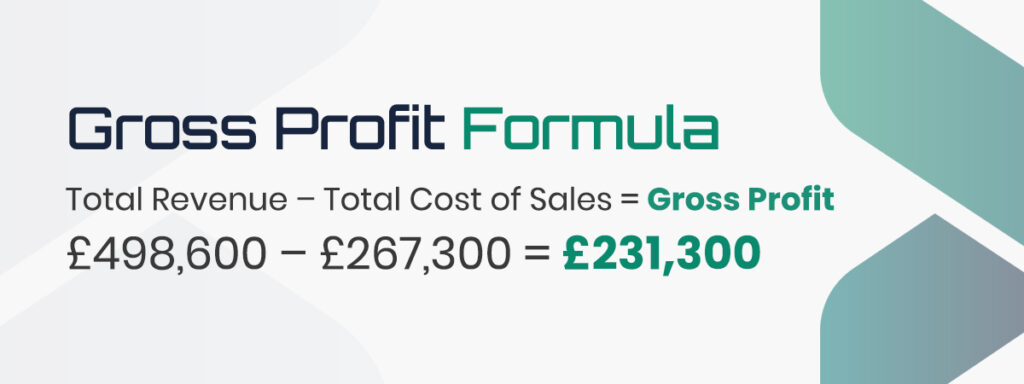
Gross Margin
Gross Margin is pretty simple too, it is just your Gross Profit (which we calculated in the previous step) divided by your total revenue and the result is expressed as a percentage and in this case it’s 46.4%. Gross Margin is a key indicator, and it should always be constant because even if sales revenue goes up or down, your cost of sales should go up or down with it. So as long as you’ve got your cost classification right and your costs of sales are truly variable then the Gross Margin percentage should always be the same.
- Gross Profit/Total Revenue = Gross Margin.
- E.g. 231,300/498,600 = 46.4%.
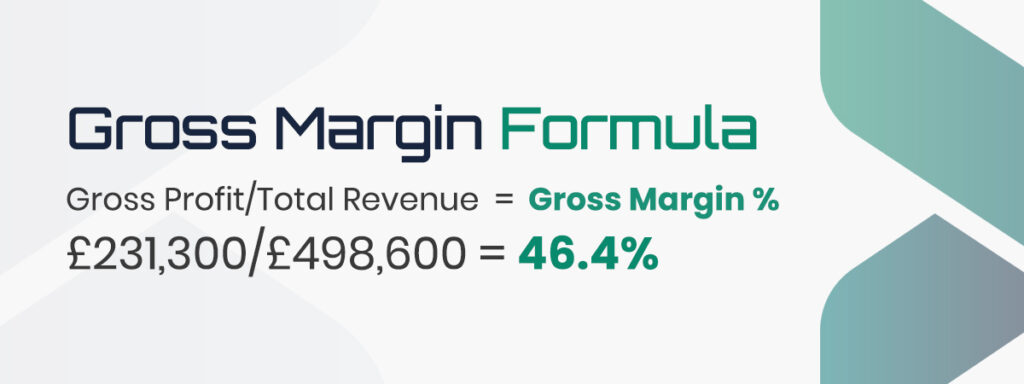
Breakeven Gross Profit
Breakeven Gross Profit is simply your total overhead costs, if you take that number then it gives you the amount of Gross Profit needed for you to breakeven.
- Total Overhead Costs (Fixed Costs) = Breakeven Gross Profit.
- E.g. 170,636 = 170,636.
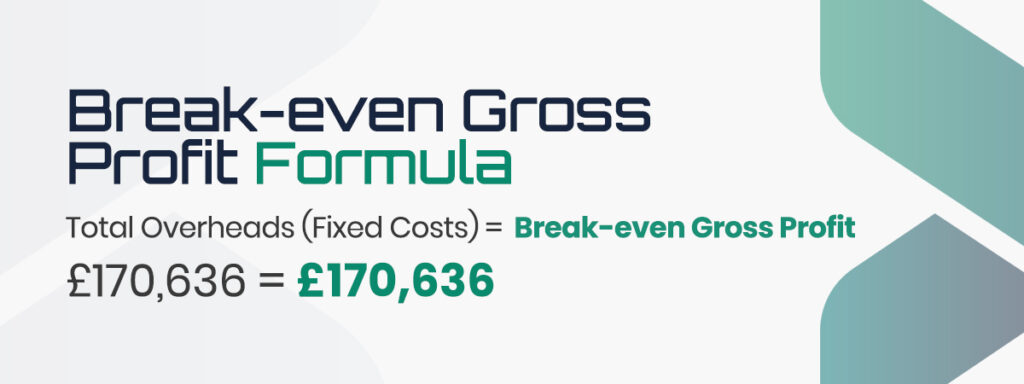
Breakeven Sales Revenue
Breakeven Sales Revenue can be calculated by taking the previous two figures for total overhead costs and Gross Margin percentage (both calculated in previous sections) and dividing total overhead costs by the Gross Margin percentage. This tells you the amount of sales you need to achieve in order to breakeven.
Total Overheads/Gross Margin (%) = Breakeven Sales Revenue.
- E.g. 170,636/46.4% = 367,830.
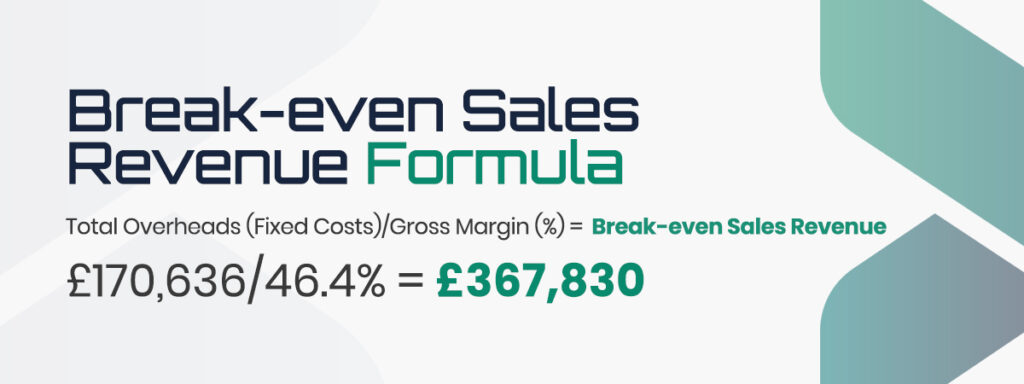
Margin of Safety
Margin of Safety is the difference between your budgeted sales revenue (sales revenue you expect to achieve and have thus accounted for in your budget for the month) and breakeven sales revenue, it’s effectively how much of a ‘cushion’ you have between your expected performance and your breakeven point. It essentially means that this figure is what you can afford to drop or underperform by and still be safe, at least breaking even and not making a loss.
Budgeted Sales Revenue – Breakeven Sales Revenue = Margin of Safety.
- This can be expressed as a raw figure like this, rounded up to 131k or it can be expressed as a percentage, which would be 26%, and it means we can afford to drop sales by around £131k or 26% and still breakeven.
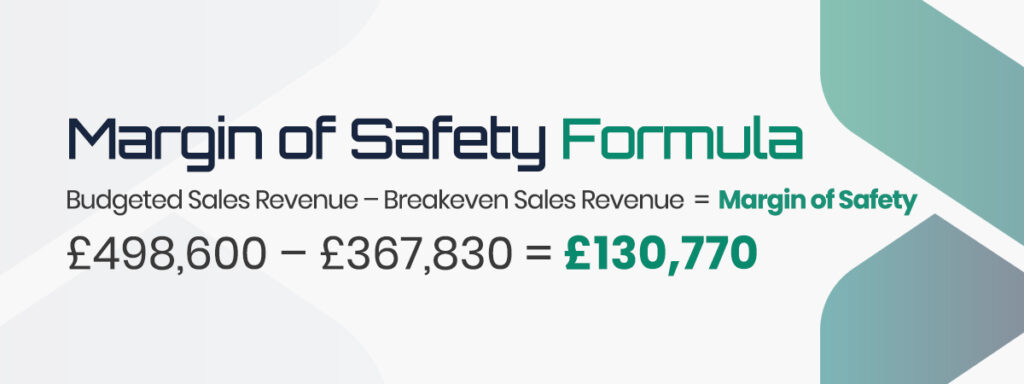
Conclusions
Assessing Economic Viability
Breakeven analysis is key to assessing Economic Viability because after your Performance Evaluation you might have fallen short of your budget, but this doesn’t necessarily mean you’ve failed, you haven’t hit what you expected to, but you might still be fine.
Why Viability is Key
This is the crucial importance of breakeven analysis because it tells you what you need to do to survive, which you need to be able to do first before you can grow and thrive; if the business can’t even survive then it’s not economically viable and will make a loss and need to shut down, which of course can’t make any profit.
Making Money vs Making a Loss
There’s a big difference between not making as much money as we’d like to in ideal circumstances and making a loss, as long as some money is made then you’ll be able to adjust and improve to aid your growth.
Find out more in the video below:
If you have found this article interesting and would like to find out more see Adrian’s book – Achieving Profitable Growth